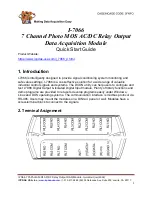
SDM-CVO4 4-Channel Current/Voltage Output Module
15
Use the point slope equation to scale the measured values. Include the
SDMCV04()
instruction after the mathematical expressions used to scale the
sensor measurements.
Use the same scan rate for the sensor measurement instructions and the
SDMCVO4()
instruction. As the required output levels are held in a digital
form in the SDM-CVO4, there is little advantage in sending data more
frequently – the only benefit being that it would recover more quickly in the
event of a loss of power.
8.2 Providing Excitation Supplies to Sensors
One application for this device is to provide excitation to a sensor or sensors.
Use the SDM-CVO4 to excite the sensor when a sensor requires a precise
voltage or current excitation that cannot be provided by the data logger, or
when exciting the sensor from the data logger or its power supply will cause a
common-mode measurement error. An example of the latter problem is where
the sensor outputs are not within the common-mode voltage that the data
logger will accept.
Using the SDM-CVO4 to provide sensor excitation can result in less accurate
measurements. Data logger excitation is a ratiometric measurement that
compensates for drift in the data logger excitation output. With the
SDM-CVO4 as an excitation source, the SDM-CVO4 excitation output drift
combines with the data logger measurement errors. When considering whether
to use the SDM-CVO4 to supply voltage or current excitation, remember that
some sensors may accept a lower excitation voltage or current than their
specifications recommend. For example, pressure sensors often recommend
10 V excitation, but may accept a lower excitation voltage that the data logger
can provide. If buying new sensors for a project, check for sensor versions that
will accept a low voltage excitation.
Some sensors have active components or have large common mode output
voltages that require an isolated and/or precise high voltage supply within the
current output capability of the SDM-CVO4. In this context, the SDM-CVO4
can provide an isolated supply, a regulated voltage (0 to 10,000 mV), a
regulated current (0 to 20 mA), or an unregulated 15 V (nominal) supply (by
setting current output mode and using the
V
o
terminal).
If all SDM-CVO4 channels are used for exciting sensors, use the standby mode
between measurements to save power. To do this, send a command
(
SDMCVO4()
with zero reps) to the SDM-CVO4 to shut it down after making
the measurements. When using this mode, allow at least 100 ms after turning
the SDM-CVO4 on again (by using
SDMCVO4()
with a non-zero number of
reps) for the outputs to stabilize, before starting your measurement sequence.
To power more than one sensor from each SDM-CVO4 output, use either a
parallel connection in voltage output mode or serial connection in current
output mode. Make sure enough current is available in the voltage mode. Also,
check that sensor outputs do not have a spread that exceeds the common mode
range of the data logger inputs.








































